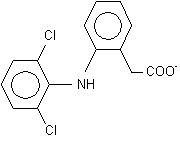Nonsteroidal anti-inflammatory drugs (NSAIDs) are used in the treatment of patients with rheumatoid arthritis and act by inhibiting cyclooxygenase enzymes. Limitations of NSAIDs include the risk of gastrointestinal (GI) mucosal injury (e.g., ulcer, perforation, hemorrhage). Cyclooxygenase enzymes are essential in producing GI-protective prostaglandins and are believed to occur in at least two forms. Pain and inflammation are predominately mediated by cyclooxygenase-2 enzymes. Conversely, cyclooxygenase-1 enzymes produce prostaglandins involved in cytoprotective function (i.e., as in GI tract mucosa). Although all NSAIDs inhibit both forms of cyclooxygenase enzymes, agents such as celecoxib are highly selective for cyclooxygenase-2 enzymes and could provide anti-inflammatory and analgesic benefits without adverse GI effects. Emery and colleagues compared the efficacy of gastrointestinal safety and the tolerability of long-term therapy using celecoxib with diclofenac therapy in the management of patients with rheumatoid arthritis.
An international, multicenter study enrolled 655 patients who met the American Rheumatism Association criteria for adult-onset rheumatoid arthritis of six months' duration and with a functional capacity of level III or less. Patients were enrolled if they were expected to require long-term NSAID therapy during the trial and had no contraindication to the study medications. Patients were randomly assigned to receive 200 mg of celecoxib twice daily or 75 mg of diclofenac SR twice daily for 24 weeks. The drugs were identical, and the study was double-blinded. Use of other medications was strictly controlled during the study. All patients underwent pretreatment screening that included medical history, physical examination and laboratory tests up to seven days before the first dose of the study medication. Efficacy and tolerability were assessed at baseline and every four weeks during treatment or to the time of withdrawal. Efficacy in controlling rheumatoid arthritis symptoms was assessed through patient and physician monitoring of disease status, functional disability scores and C-reactive protein levels. GI and overall tolerability of treatment were monitored through observation and report of adverse events, physical examination and laboratory testing. GI safety was assessed with upper GI endoscopy that was performed during week 24 of treatment, at the time of withdrawal from the study or no more than seven days after the last dose of study drug. GI endoscopy was unavailable at all study sites.
At baseline, the 326 patients treated with celecoxib were similar to the 329 patients who received diclofenac in demographics, duration of rheumatoid arthritis, history of GI disease and NSAID intolerance. At baseline, patients assigned to the diclofenac group had a significantly higher mean pain score and a longer duration of morning stiffness, and were more likely to be taking corticosteroids than were patients assigned to the celecoxib group. During treatment, both groups improved in primary and secondary measures of pain and inflammation associated with rheumatoid arthritis. No significant differences in efficacy were found between the two treatment groups. Lack of therapeutic efficacy resulted in a withdrawal rate of 8 percent of patients treated with celecoxib and 7 percent of patients treated with diclofenac.
Conversely, the withdrawal rate for GI adverse events was significantly higher in patients taking diclofenac (16 percent) than in patients taking celecoxib (6 percent). Patients in the diclofenac group also withdrew at an earlier stage of treatment. Overall, GI adverse effects were reported by 48 percent of patients taking diclofenac compared with 36 percent of those taking celecoxib. Most adverse events were mild to moderate, but five patients in the diclofenac group required hospital admission. Ulcers were detected in the stomach or duodenum in 33 (15 percent) of the patients in the diclofenac group and eight (4 percent) of those in the celecoxib group. Other adverse events (e.g., diarrhea, headache, fatigue) were not significantly more common in either treatment group. Mean hemoglobin levels decreased during diclofenac therapy but remained unchanged during treatment with celecoxib. Liver function enzyme levels also significantly increased during diclofenac treatment; however, these levels remained the same or decreased slightly during celecoxib treatment.
The authors conclude that celecoxib exhibits anti-inflammatory and analgesic activity comparable to that of diclofenac, but results in significantly better GI tolerability and safety.
ANNE D. WALLING, M.D.
Emery P, et al. Celecoxib versus diclofenac in long-term management of rheumatoid arthritis: randomised double-blind comparison. Lancet December 18/25, 1999;354: 2106-11.
COPYRIGHT 2000 American Academy of Family Physicians
COPYRIGHT 2000 Gale Group



